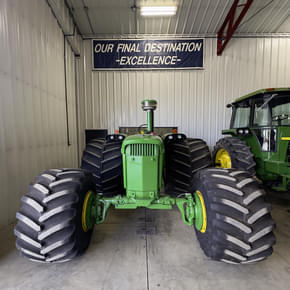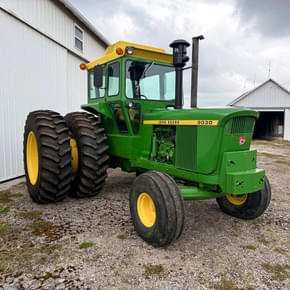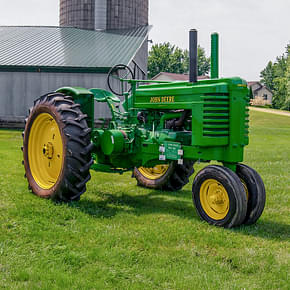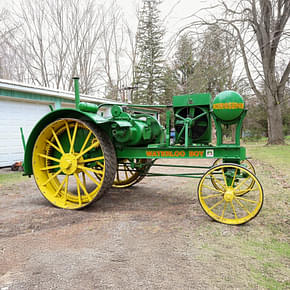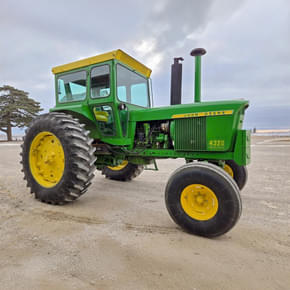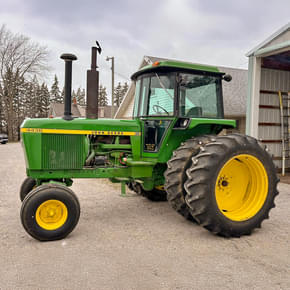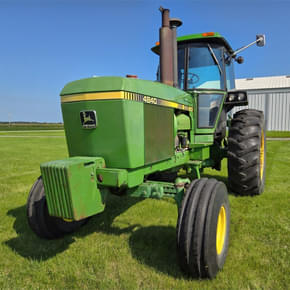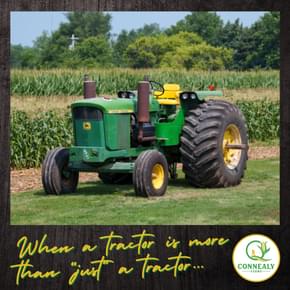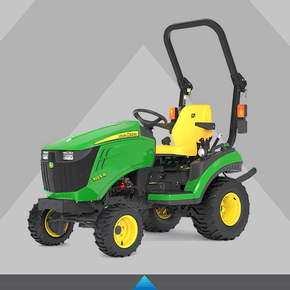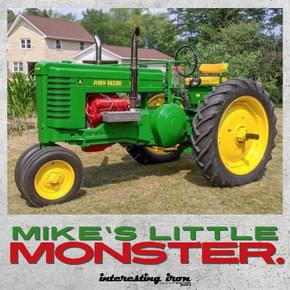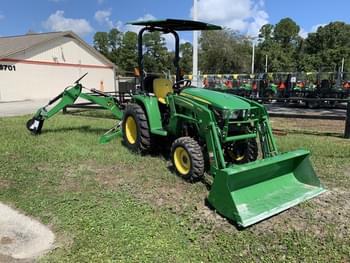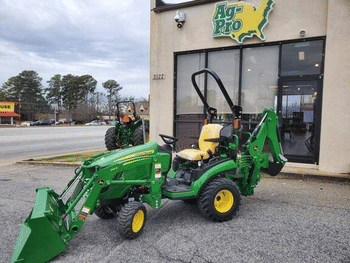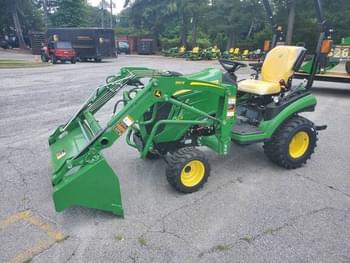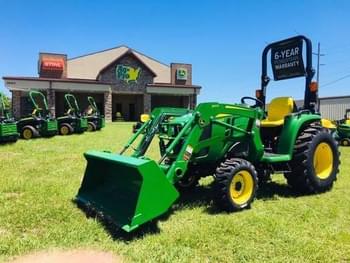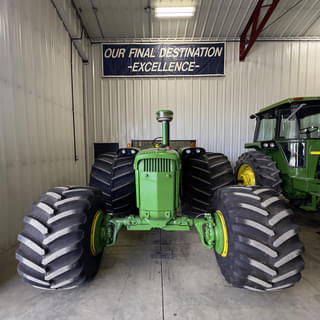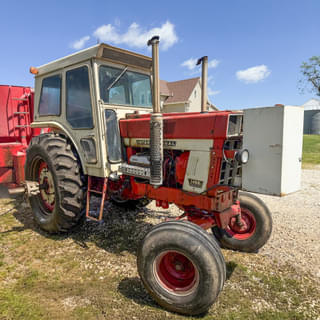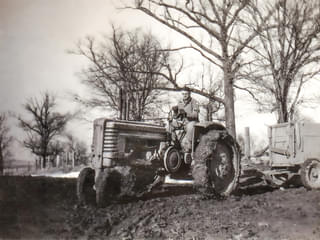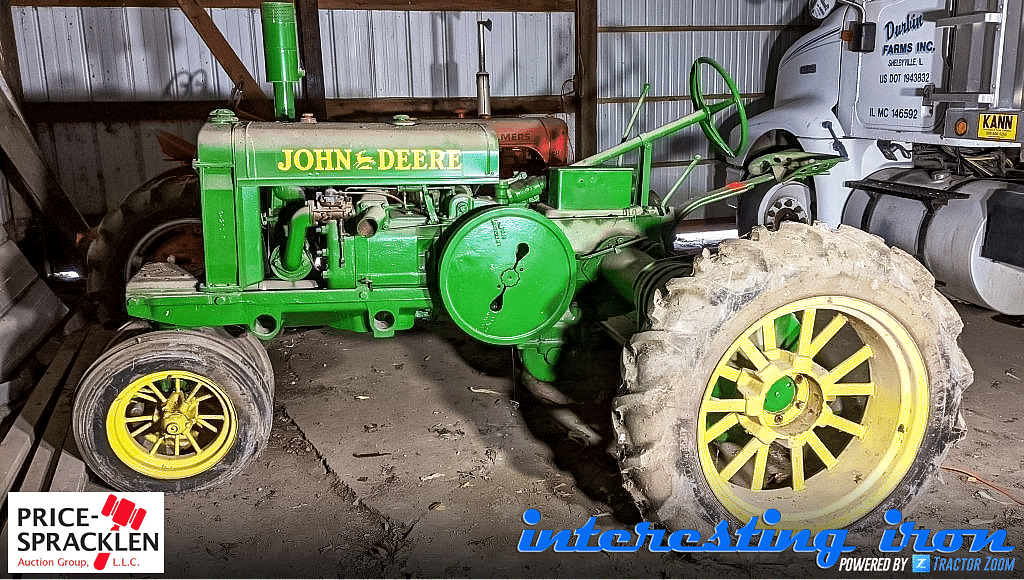
See the details on this John Deere GP.
In the mid-20s, John Deere was in desperate need of a tractor to compete with Harvester’s new do-it-all tractor – the Farmall Regular. The Farmall Regular was a highly successful row-crop tractor that was rated for about 13 horse, or enough to pull a two-bottom plow.
Initially, Deere’s answer was the Model C – a tractor that I don’t believe they were ever really happy with. It was pulled from the market and several different changes were made all within about 10 months. The resulting tractor was renamed the John Deere GP (General Purpose) and what you see here is a variant thereof…the Wide Tread.
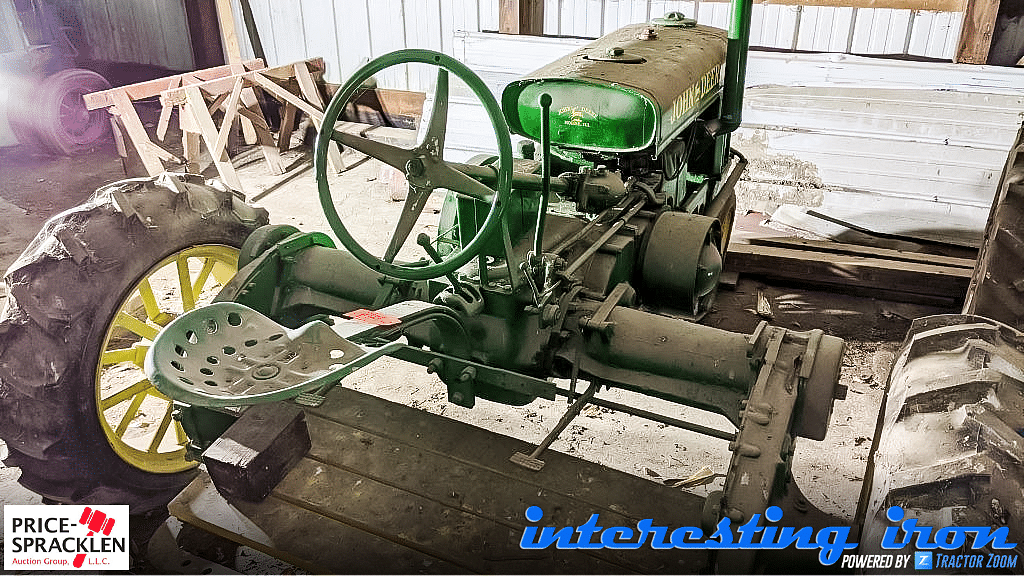
Deere built the GP and its variants for roughly 7 years, from 1928-1935. Honestly, the tractors weren’t super-successful. They were heavy and underpowered, and quite frankly, there were some design issues that plagued the early tractors. They did manage to sell around 36,000 of them give or take a few, but the Farmall Regular was the clear winner in this fight.
The Wide Tread model was the first row-crop design for Deere, and it was definitely the most successful of the variants. Although it took a few different design changes for them to feel like they got it right, it did finally come together. CEO Charles Wiman was openly critical of how the Company had handled the design and development of the GP tractors. He considered the GP to be one of his biggest failures as a leader.
Personally, I think he did a terrific job of leading the charge – mainly because the company learned from their mistakes, and kept working tirelessly to fix the issues and make a better machine. That’s what the farmer needed, and Deere was devoted to making the product work!
The GP by the numbers
I’ve heard/found differing numbers as far as GP production goes, but all in all, there were somewhere in the neighborhood of 36-37,000 tractors built. It gets tricky because a few tractors ended up being recalled and rebuilt/resold with different options but using the same serial number, etc.
That said, here’s a basic breakdown.
GP: 30, 535
GP-WT: 5,103
GP-P (a modified GPWT specially made for potato farmers): 203
GP-O (Orchard): 717
Additionally, there was a fairly major design change in the GP-WT’s steering system that moved the linkage from the side (like you see on the tractor in the picture) to the top of the hood like you’d find on the Model A. The last 443 GP-WTs were all built this way, and they’re HIGHLY collectible.
So yeah, like I said…tracking production numbers on the John Deere GP is a little tricky.
The GP-WT at auction
I honestly don’t have a lot of information to go on with this tractor. Here’s what I know (or what I think I know). I’m just about positive that this tractor is a 1930 or maybe a 1931 model (I don’t have a serial number for it yet, but I’ve got a phone call in to the auctioneer). It currently lives in southern Illinois, and it sells to the highest bidder next Tuesday, March 2!
As I get more information on it, I’ll update the post. For now, though, there’s not much to go on.
Deere’s leadership during the Great Depression
Ever wonder why so many farmer families have been bleeding green for literally decades? The foundation of that brand loyalty was laid during some of the toughest years in America’s modern history…the 1930s. Deere was devoted to its workers and the farmer, and they showed it in several major ways.
Loyal to their employees
During the early years of the Great Depression, Deere’s sales plummeted over 85% in less than two years (1930-1932), forcing major cuts and a huge layoff. It was a horrible time to be in business. Still, Deere & Co. maintained a tremendous loyalty to their employees. They still paid 5% interest on employee savings accounts and they still maintained the group insurance policies for laid-off workers. But it didn’t stop there…
The People’s Bank of Moline was known to be where Deere & Company kept their accounts, and many of their employees banked there as well. In 1930 or 1931 – I’m not sure which – that bank found itself on the brink of collapse due to an internal embezzlement scheme. Deere’s CEO, Charles Wiman, brought the Board of Directors together on the day the bank was supposed to close. He made a motion to cover the bank’s losses – nearly $1.3 million! He stated, “If we do not do this, the bank closes…As I view it, there are appromixately $7 million of savings deposits in this bank, largely made by the wage earners of our factories, and the effects upon them of closing the bank, and the resulting consequences to this Company, are beyond calculation.”
That very day, Deere cut a check to the bank for $1.29 million to cover the losses, and kept that bank afloat. In turn, they saved the deposits of a great deal of their employees as well. From where I’m sitting, it was a pivotal moment in the world of corporate responsibility.
Loyal to the American farmer
Still, Deere wasn’t done. In 1931 alone, Deere assumed $12 million in farmer loans for equipment. For some farmers, they were the only institution that would extend credit. That was a tremendous show of faith on Deere’s part towards their customers. They knew that in addition to keeping the Company afloat, they needed to also extend a hand to the American farmer.
In an unprecedented move, Deere extended the terms on ALL of its loans to farmers. For every piece of machinery that cost more than $200, Deere extended terms to a full three years. In doing so, it helped literally thousands of farmers keep their equipment; for many, that economic relief was the difference between keeping the land and losing it!
Why did Deere do all of this? Because they knew that at the end of the day, they were forming a bond with their customers. It was a relationship that was so much more than company/customer. Deere’s actions during the early years of the Great Depression expressed faith in the farmer and helped preserve the farmer’s dignity. Farmers take a lot of pride in their occupation, and Deere’s faith in them was enough to turn red blood into green.
(Read more about how the GP-WT played into Deere’s leadership in the Great Depression here.)
(This is where I go off-script for a bit…)
Nearly every time I spotlight an older Deere on any of our social channels, I’m pretty much guaranteed to get a bevy of comments that range from “that’s the best tractor ever built!” to “the overpriced plastic tractors they make today are hot garbage blah blah blah.”
Opinions get loud and pretty fiesty, and sometimes the snide comments get pretty old, honestly.
The way companies do business has changed a lot over the years, and sometimes it ruffles feathers. That’s what happens when a company grows into a business with a large global footprint. Is any company perfect? Surely not. Deere isn’t. They’ve made plenty of mistakes along the way, and they’ve suffered the consequences, too.
I’m not sure that there’s a company in agriculture today that takes more heat for the way they run their business than John Deere. That’s okay, too; we live in a world of very diverse opinions, and everybody is entitled to their own opinion. However…at the end of the day, I don’t think it’s fair to question their devotion to the farmer.

